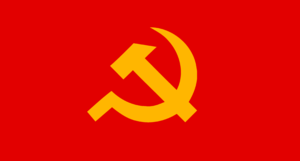No edit summary Tag: 2017 source edit |
Tag: 2017 source edit |
||
| Line 48: | Line 48: | ||
==Anarchist Perspective on Communism== | ==Anarchist Perspective on Communism== | ||
[[File:Ancom.png]] [[Anarcho-Communism|Communist anarchists]] argue that the liberation of the working class and the establishment of communism must occur simultaneously, without one phase serving as a prerequisite for the other. | [[File:Ancom.png]] [[Anarcho-Communism|Communist anarchists]] argue that the liberation of the working class and the establishment of communism must occur simultaneously, without one phase serving as a prerequisite for the other. These anarchists believe that the state and all forms of [[File:Thar.png]] [[Anti-Authoritarianism|hierarchy should be abolished]] from the outset, as any form of authority can potentially lead to the re-emergence of oppressive structures. | ||
Communist anarchists describe a society where the means of production and resources are owned collectively and managed by local communities or worker councils. Production and distribution are organized according to the principles of "from each according to their ability, to each according to their needs." Without private property or profit motives, goods and services are distributed based on genuine needs rather than market forces. | Communist anarchists describe a society where the means of production and resources are owned collectively and managed by local communities or worker councils. Production and distribution are organized according to the principles of "from each according to their ability, to each according to their needs." Without private property or profit motives, goods and services are distributed based on genuine needs rather than market forces. | ||
Revision as of 22:53, 23 September 2023
Communism is the mode of production in which classes have been abolished, and through this the state and commodities (most importantly money) have been abolished, and a society based upon distribution from each according to ability to each according to need has been achieved.
Although most famously theorized by ![]() Karl Marx and Friedrich Engels, there were numerous other proponents of communism/similar societies that differed from Marx and Engels on tactics and strategies to achieve such a society, such as Mikhail Bakunin and Peter Kropotkin.
Karl Marx and Friedrich Engels, there were numerous other proponents of communism/similar societies that differed from Marx and Engels on tactics and strategies to achieve such a society, such as Mikhail Bakunin and Peter Kropotkin.
Marxist Perspective on Communism
![]() Marxists separate communism into two phases: lower-phase communism (
Marxists separate communism into two phases: lower-phase communism (![]() Socialism) and higher-phase communism (
Socialism) and higher-phase communism (![]() Communism). Before either of these phases are to be possible, Marxists see the need for the destruction of the bourgeois state and the building of a proletarian state that would enforce the will of the working class while crushing the bourgeoisie.
Communism). Before either of these phases are to be possible, Marxists see the need for the destruction of the bourgeois state and the building of a proletarian state that would enforce the will of the working class while crushing the bourgeoisie.
Lower-phase communism according to Marx sees the abolition of classes and of commodity production (and therefore money). However, this society is still scarred by the birthmarks of the old society, namely the state which while beginning to wither still exists in a sense. This stage can not happen instantly according to Marxists, as the dictatorship of the proletariat, while doing as much as it can to abolish classes, can not do so hastily and the process of building towards communism is a slow one.
Higher-phase communism according to Marx sees the full withering away of the state and all its institutions and its replacement with an association of producers. Classes and money by this point have withered away, and society is based upon distribution based upon needs and abilities.
Anarchist Perspective on Communism
![]() Communist anarchists argue that the liberation of the working class and the establishment of communism must occur simultaneously, without one phase serving as a prerequisite for the other. These anarchists believe that the state and all forms of
Communist anarchists argue that the liberation of the working class and the establishment of communism must occur simultaneously, without one phase serving as a prerequisite for the other. These anarchists believe that the state and all forms of ![]() hierarchy should be abolished from the outset, as any form of authority can potentially lead to the re-emergence of oppressive structures.
hierarchy should be abolished from the outset, as any form of authority can potentially lead to the re-emergence of oppressive structures.
Communist anarchists describe a society where the means of production and resources are owned collectively and managed by local communities or worker councils. Production and distribution are organized according to the principles of "from each according to their ability, to each according to their needs." Without private property or profit motives, goods and services are distributed based on genuine needs rather than market forces.
How to Draw

- Draw a ball with a black outline.
- Fill with red.
- Draw a Hammer and Sickle in gold.
- Add the eyes.
- Done!
| Color Name | HEX | RGB | |
|---|---|---|---|
| Red | #CC0000 | 204, 0, 0 | |
| Gold | #FFD700 | 255, 215, 0 | |
Relationships
Further Information